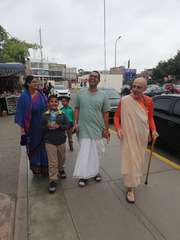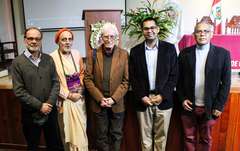Hare Krishna Gurudeva
Please accept my humble obeisances,
All glories to Srila Prabhupada !!
This report is about the progress of the indexing process and the final part of the edition for the publication of SOLARIS No 5, by the mercy of Srila Bhaktivinoda Thakur, we hope to have the digital version of the magazine ready on the day of its Glorious Appearance on 30 of August.
HpS - Enthusiasm is more important than patience but without some patience turns into patience. We all look forward to the Big Voice of NIOS.
We have been in permanent communication with Miguel Polo and Héctor Béjar. With Miguel, after several sessions we have defined the standard for the presentation of the journal's articles and contents (it is the first requirement in the indexing process). In Héctor's case, he has read articles to approve their publication. In my case, as editor and coordinator of the journal, I have managed with professors and institutions the preparation and delivery of articles and content (it only remains to refine the details of the part in English to finish this point), I have also managed with the CIEPS - Center International Registration of Serial Publications the assignment of two ISSNs (one to ratify the printed version and another number for the digital version), finally, at the moment I am in the design and layout (80% ready).
HpS - Gandhava Das made excellent presentation for Viplavah etc. today in NIOS Board of Director's meeting. Everyone was very impressed. We have to put the management of NIOS in the loop as we apply for these numbers etc. Excellent work.
The work of homologizing and standardizing SOLARIS is very strong, but it is necessary, to pass, the first filter of the indexing. They are formalities, they are not difficult, but if they are laborious, they are not unnecessary formalities, on the contrary, this is currently the standard of how scientific and academic information is ordered and cataloged in the world. Basically, this first step (two more to go) consists of 3 topics:
1.- Standardize the presentation of articles according to the pattern established by the APA (American Psychological Association). The set of these standards is what is known as the APA style or standards. We follow the APA 6 style, this was the recommendation of Miguel and also of another professor, who has already indexed his journal (at this point we appreciate the valuable work of Carlos Rold who approved the footnotes and bibliographic references of almost all articles, in Spanish, he also did a bit of proofreading, a super service).
HpS - Jaya, Bhakta Carlitos.
2.- Create for each article a DOI (Digital Object Identifier) is a unique and permanent identifier that provides information on the description of digital objects (in our case the articles and other contents of the journal) this makes it easy and accessible the location of content on the internet.
3.- Build a portal (your own website) where the articles can be downloaded in thematic or chronological order through metadata (author, title, publication data, etc.) this is in the process of being elaborated (in the next report more details on this point).
HpS - This was also discussed at the BOD meeting today. Subal sakha Das from Richmond, Virginia, can possible help us with general strategy for the website and NIOS web pages. His company charges $500/hour when he does this work. He will design and manage the work of teams of 25-programers as they migrate Capitol One bank's account date from one server to another in a live process over 18-hours. If it fails while moving they start losing $27,000 per hour!
In parallel, we have the validation of articles by pairs, that is, a group of academics who approve the publication of the articles in the journal.
At this point the English editing team (they can delegate validation to other colleagues) would be made up of Radhika Raman and Aja-Govinda, (humanities and applied sciences, great), okay?
HpS - Maybe!!!? We can always be fully engaged. If we become anxious for some material result, fame, prestige, I know!, then we create problems. Aja and Radhika are both pushed to the limit with their academic, profession, family, ISKCON responsibilities. ... Maybe they will not have time to do this. We have to look at things and see if we can do it. If not then O.K. we will do something else and GET a good result. Better to do something smaller with 85% good result that something bigger with 15% result, no?
The Spanish team is made up of Héctor Béjar (agrees to evaluate two articles per Magazine) Miguel Polo (agrees to evaluate two or three articles per Magazine) Paula Miranda and Lalita-gopi D.D. (Ramon Mujica, Carlos Aquino, Walter León and others are also there but they are occasional)
Here is the content of SOLARIS No 5:
INDEX / INDEX
Articles / Articles:
1. THE SACRED FOR HUMAN SURVIVAL, Kalyan Kumar Chakravarty.
2. EDUCATION, NATURE AND THE PARADIGM OF THE SACRED, Héctor Béjar Rivera.
3. A BHAGAVATA PHILOSOPHY OF EDUCATION, Some Preliminary Thoughts, Ravi Gupta.
4. NARRATIVE AND SPIRITUALITY IN FRONT OF POSTHUMANISM, Luis Arturo Amaro Sáenz.
5. FROM THE NATURE OF ART TO THE ART OF NATURE, Raúl Zevallos.
6. THE VISUAL DISCOURSE IN THE CENTENNIAL GENERATIONS, education for a global ethics, Ma. Dolores Chávez.
7. IMAGE OF THE ORIENTAL AND INDIA SOCIETIES IN THE PERCEPTION OF LATIN AMERICAN AUTHORS, Murad Ahamad Khan.
8. THE RETURN TO THE WORLD IN DŌGEN AND IN SHINRAN: THE PRACTICE OF ZAZEN AND NENBUTSU, Rebeca Maldonado.
● Cultural Portal / Cultural Portal:
POETRY, A WAY TOWARDS THE REUNION WITH THE SACRED. In Memoriam by Rodrigo Hernández Piceros, by Carlos Rold / illustrations: Sebastián Riveros.
A POET DRESSED IN HUMILITY, Enrique de Santiago.
● Interviews / Interviews
THE ROLE OF CREATIVITY IN ZEN BUDDHISM, Miguel Polo interview with Berta Meneses.
● Round table / Round table
KARMA-VIRUS or KARUNA-VIRUS, approaches to the implications of the COVID-19 pandemic
● Reviews / Reviews
● Institutional Exchanges / Institutional Exchanges
Gurudeva, by your mercy and that of Sri Gauranga, the academic sankirtana is going well, in the next report we will talk about the interesting relationships of NIOS and SOLARIS with the Spanish Society of Religions Sciences (www.secr.es) (Spain) and the Aesthetics Center of the Catholic University of Chile (www.estetica.uc.cl).
Hare Krishna Gurudeva, his insignificant servant, Abhirama Thakur das.
HpS - Again, be careful. Keep it enthusiasm, not passion. We are just now beginning to get these projects into the Blog as practical works. Should have happened some time before, but no body (especially us) are perfect.
All glories to His Divine Grace. We all thank you! We thank Maria for giving your so much love and respect.
EDICIÓN Y PUBLICACIÓN DE SOLARIS No 5 EN LA RECTA FINAL
Hare Krishna Gurudeva
Por favor acepte mis humildes reverencias,
¡Todas las glorias a Srila Prabhupada!!
Este informe es sobre el avance del proceso de indexación y la parte final de la edición para la publicación de SOLARIS No 5, por la misericordia de Srila Bhaktivinoda Thakur, esperamos tener la versión digital de la revista lista el día de su Gloriosa Aparición el 30 de agosto. A continuación, los detalles:
Hemos estado en comunicación permanente con Miguel Polo y con Héctor Béjar. Con Miguel, después de varias sesiones hemos definido el estándar de la presentación de los artículos y contenidos de la revista (es el primer requisito en el trámite de indexación), en el caso de Héctor él ha leído artículos para aprobar su publicación. En mi caso, como editor y coordinador de la revista he gestionado con profesores e instituciones la elaboración y entrega de artículos y contenidos (solo falta afinar los detalles de la parte en inglés para acabar este punto), también he gestionado con la CIEPS – Centro Internacional de Registro de Publicaciones en Serie la asignación de dos ISSN (uno para ratificar la versión impresa y otro número para la versión digital), finalmente, en estos momentos me encuentro en el diseño y la diagramación (80% listos).
El trabajo de homologar y estandarizar SOLARIS es muy fuerte, pero es necesario para pasar el primer filtro de la indexación. Son formalidades, no son difíciles, pero si laboriosas, no son formalidades innecesarias, al contrario, este es actualmente el estándar de cómo está ordenada y catalogada la información científica y académica en el mundo. Básicamente, este primer paso (faltan dos más) consta de 3 temas:
1.- Homologar la presentación de los artículos de acuerdo al patrón establecido por la APA (American Psychological Association). El conjunto de estas normas es lo que se conoce como el estilo o normas APA. Nosotros seguimos el estilo APA 6, esta fue la recomendación de Miguel y también de otro profesor, que ya indexó su revista (en este punto agradecemos el valioso trabajo de Carlos Rold que homologó las notas al pie y referencias bibliografías de casi todos los artículos, en español, también hizo un poco de corrección de estilo, un súper servicio)
2.- Crear para cada artículo un DOI (Digital Object Identifier) es un identificador único y permanente que proporciona información sobre la descripción de objetos digitales (en nuestro caso los artículos y otros contenidos de la revista) esto hace fácil y accesible la localización de los contenidos en internet.
3.- Construir un portal (una website propia) donde se puedan descargar los artículos por orden temático o cronológico a través de metadatos (autor, título, datos de publicación, etc.) esto está en pleno proceso de elaboración (en el próximo informe mas detalles de este punto).
Paralelamente, tenemos la validación de artículos por pares, es decir, un conjunto de académicos que aprueben la publicación de los artículos en la revista.
En este punto el equipo editor en inglés (ellos pueden delegar a otros colegas la validación) estaría conformado por Radhika Raman y Aja-Govinda, (humanidades y ciencias aplicadas, buenísimo) ¿está bien?
El equipo en español está conformado por Héctor Béjar (se compromete a evaluar dos artículos por Revista) Miguel Polo (se compromete a evaluar dos o tres artículos por Revista) Paula Miranda y Lalita-gopi D.D. (también están Ramon Mujica, Carlos Aquino, Walter León y otros pero ellos son ocasionales)
A continuación, el contenido de SOLARIS No 5:
INDEX / ÍNDICE
Articles / Artículos:
- THE SACRED FOR HUMAN SURVIVAL, Kalyan Kumar Chakravarty.
- EDUCATION, NATURE AND THE PARADIGM OF THE SACRED, Héctor Béjar Rivera.
- A BHAGAVATA PHILOSOPHY OF EDUCATION, Some Preliminary Thoughts, Ravi Gupta.
- NARRATIVA Y ESPIRITUALIDAD FRENTE AL POSTHUMANISMO, Luis Arturo Amaro Sáenz.
- DE LA NATURALEZA DEL ARTE AL ARTE DE LA NATURALEZA, Raúl Zevallos.
- EL DISCURSO VISUAL EN LAS GENERACIONES CENTENNIALS, educación para una ética global, Dra. Ma. Dolores Chávez.
- IMAGEN DE LAS SOCIEDADES ORIENTALES E INDIA EN LA PERCEPCIÓN DE LOS AUTORES LATINOAMERICANOS, Murad Ahamad Khan.
- EL REGRESO AL MUNDO EN DŌGEN Y EN SHINRAN: LA PRÁCTICA DE ZAZEN Y DEL NENBUTSU. SOBRE LA COMPRENSIÓN DE LA ENSEÑANZA EN LA ERA KAMAKURA DE DOS BUDISMOS OPUESTOS ENTRE SÍ, Rebeca Maldonado.
● Cultural Portal / Portal Cultural:
LA POESÍA, UN CAMINO HACIA EL REENCUENTRO CON LO SAGRADO. In Memoriam de Rodrigo Hernández Piceros, por Carlos Rold / ilustraciones: Sebastián Riveros.
UN POETA VESTIDO DE HUMILDAD, Enrique de Santiago.
● Interviews / Entrevistas
EL PAPEL DE LA CREATIVIDAD EN EL BUDISMO ZEN, entrevista de Miguel Polo a Berta Meneses.
● Round table / Mesa redonda
KARMA-VIRUS o KARUNA-VIRUS, aproximaciones a las implicancias de la pandemia del COVID-19
● Reviews / Reseñas
● Institutional Exchanges / Intercambios Institucionales
Gurudeva, por su misericordia y la de Sri Gauranga el sankirtana académico está marchando bien, en el siguiente informe hablaremos de las interesantes relaciones de NIOS y SOLARIS con la Sociedad Española de Ciencias de las Religiones (www.secr.es) (España) y el Centro de Estética de la Universidad Católica de Chile (www.estetica.uc.cl).
Hare Krishna Gurudeva, su insignificante sirviente, Abhirama Thakur das.


